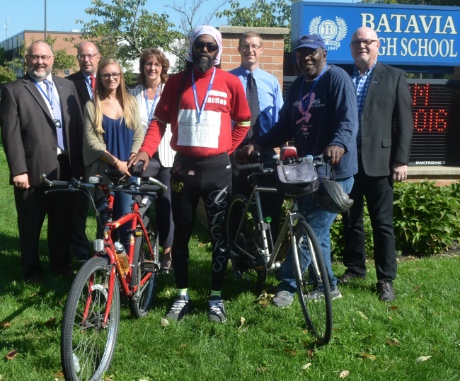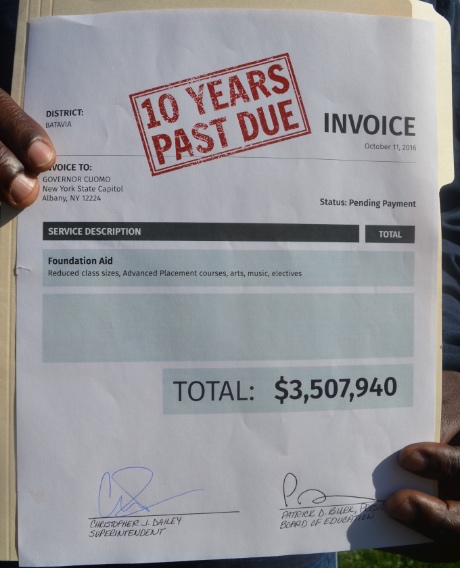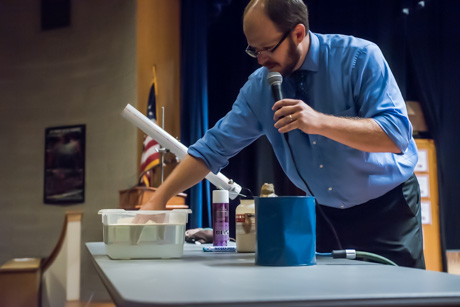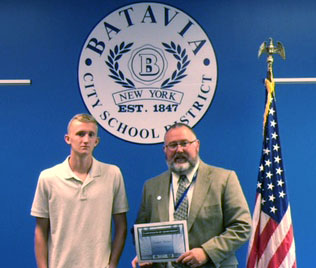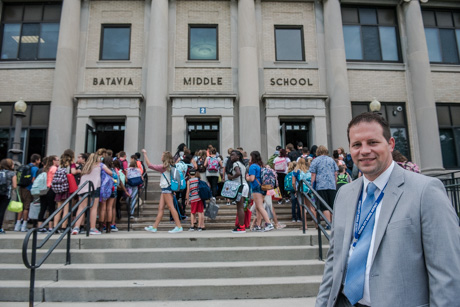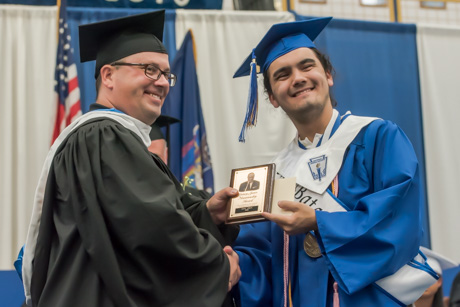The NYS Office of the Comptroller’s Division of Local Government and School Accountability recently completed a routine audit of the District’s finances to review efficiency and accountability. Looking at the period of July 1, 2012, through March 10, 2016, we are pleased to report that the audit revealed no weaknesses in internal controls, policies, practices, procedures and operations.
As a result, there no findings of fraud, waste, abuse, misconduct, or negligence.
The audit did cite one area of concern: a claim that the District did not effectively manage fund balance, which is the residual money accumulated from prior fiscal years that can be reserved for future expenditures or emergencies. When fund balances are accumulated for a targeted and specific purpose, such as saving for a capital project or an anticipated increase in retirement costs, the law specifies that the amount in these restricted funds must be “reasonable” as opposed to excessive. When a fund balance is categorized as unrestricted (containing monies not targeted for a specific upcoming expense), it must be used to lower property taxes if the amount exceeds 4 percent of the proposed budget for the coming year.
The Comptroller’s Office concluded in its most recent report that the District has too much money reserved in fund balance and debt service reserves.
Ironically, this speaks to one of the practices that the Board of Education and administration feel has been one of its greatest strengths – planning and preparing for the future, whether that be enhancing programming or facing unforeseen expenditures as we have seen in recent years with the pullback of New York State funding and the unstable financial picture.
Our philosophy has enabled the District to weather numerous constraints placed by State and federal laws, regulations, and mandates, as well as the significant unpredictability and fluctuations in both expenses and aid. While weathering these financial storms, the District has continued to deliver exceptional educational programs to our students at a per-pupil cost significantly lower than the State average, maintained a stable tax levy history for over 10 years that frequently has decreased or remained flat (with a 10-year average increase of 0.68 percent), consistently remained under the Tax Cap permissible by New York State, and, by prudent planning, earned State tax rebates for our residents for the three years that has been enacted.
Interestingly, our tax rates have decreased over the years (from 2006-07 at $24.22 per thousand of assessed valuation to $23.02 per thousand of assessed valuation in 2015-16). To analyze taxpayer impact, we conducted a study of an individual taxpayer in the District currently (in 2015-16) assessed at $106,000. The study revealed that, since the 2004-05 fiscal year (base year), the school taxes paid increased a total of $129.95, or 8.49 percent, which is an average of $11.81 or 0.77 percent a year -- amounting to less than $1 a month.
Outside of the District’s control, the taxpayer’s assessed valuation increased from $98,000 to $106,000 in 2008-09 (or an 8.16 percent change). In essence, the increase in school taxes is attributable to the increase in assessed value. Also noteworthy is that this overall increase in school taxes does not include the two rebate checks that the taxpayer received directly from NYS in 2014-15 and 2015-16 as a result of the District compliance with the Tax Cap and with efficiency established since July 1, 2012.
The Comptroller’s Office has recommended several strategies, and the District is in the process of evaluating these recommendations while remaining mindful that changes in practice must not result in significant fluctuations that will potentially harm the community in the long run nor leave taxpayers unprotected from fluctuations in the tax levy due to factors outside its control.
The report noted the belief that, from 2012-13 to 2014-15, the District had overestimated appropriations in budget projections and recommended that the District be more “realistic” as well as use more of the fund balance and reserves for the budget. First, we would clarify that this year’s pre-audited surplus is only $189,600 above the 4-percent maximum, and regarded by the Comptroller’s Office standards as a "good" budgeting process with realistic estimates.
In addition, we would like to highlight that the first couple years of the audit were the years immediately following the consolidation. Not knowing the full impact on major budgetary expenditures, such as transportation, resulted in conservative budgets in these areas. The budgeting practices have been modified, implemented, and are reflected in the 2015-16 budget results.
The District also points out that, in addition to utilizing internal staff’s expertise in analysis and projections, they also rely each year on the input from community budget ambassadors who review the budget proposals line-by-line and provide valuable feedback on the educational programs and potential modifications to the proposed budget for the Board to consider.
Regarding fluctuations in State aid, it is important to note that NYS has a history of reducing its aid to school districts. Most recently this resulted six years of reductions and, in essence, shifted the burden funding the budget to the local taxpayer if a district chose not to make changes and maintained the status quo. The District made tough decisions and changes, most markedly consolidation, and complied with the NYS Tax Cap (well before it was implemented) while receiving a cuts in State aid during these years.
Likewise, the Comptroller’s recommendation to review all reserves to determine if the amounts reserved are necessary and reasonable has been a regular part of the District’s annual budget process. In fact, one such fund, the Tax Certiorari reserve, is slated to be eliminated pending Board approval at its next summer meeting, and the Unemployment Insurance reserve is being significantly reduced. On the other hand, based on factors previously mentioned, the District’s practice is to budget conservatively for a worst-case scenario in order to protect the educational program for our students and to avoid crisis tax increases for our residents.
While there is no concrete regulation on funding amounts or limits (other than “reasonable”) on some restricted reserves, the District plans to continue its practice of periodically evaluating the reserves according to what is believed to be reasonable by District officials.
As for the Debt Service fund, which has operated as such for twenty-plus years without raising any concerns in audits, the District has reduced the balances by nearly $3 million since 2009 and has accounted for all current obligations in this Fund. In 2015, the citizens authorized a $7.5 million capital reserve fund to offset the local share of future projects beginning with the 2013 capital project.
The District will also research the current accounting method for the financing of prior capital projects. It is also important to note that Note 3 in the Comptroller’s response is incorrect. The District has always recorded transactions related to capital projects in the Capital Project fund. The accounting for long-term financing of the projects (Serial Bond principal and interest payments), along with annual revenue received (State aid, transfer from General Fund and interest earning) are the concerns cited in the audit raising the question of whether they should be recorded in General Fund or Debt Service Fund. The District will evaluate the law regarding these concerns during the 2016-17 fiscal year.
In addition, the District felt that the audit did not capture several positive initiatives, which are worthy of mention:
1. The District consolidated and restructured its educational plan in July 2012. One building was later sold and the other building is being used for some district offices along with being leased to generate additional annual revenue which results in tax levy savings. District vacant land was also sold.
2. The District partnered with the City of Batavia to approve three exemptions (Home Improvement Exemption; Mixed-Use Exemption and Inhibited Property Exemption).
3. After receiving community input, the Board approved the Alternative Veterans’ Tax Exemption.
4. The District refunded Serial Bonds in 2012 which resulted in $764,814 net present value savings.
5. Debt as a percent of the General Fund budget has been reduced from 101.87 percent as of June 30, 2008, to 39.19 percent as of June 30, 2016.
6. Taxpayers this year will be receiving their third (out of three opportunities) rebate check directly from New York State as a result of District compliance with the New York State Tax Cap law and efficiencies undertaken since July 2012.
7. In the five years since the New York State Tax Cap, the District tax levy has increased an average of 0.80 percent, while the allowable increase was 3.15 percent. In dollars, this amounted to a $2,146,484 total tax levy less than allowed. Also, three of the last four years (through 2016-17), have had no increase of the tax levy and the average increase is less than 0.50 percent. As previously mentioned, the 10-year average tax levy (five years prior to the 2012 Tax Cap law) is 0.68 percent.
8. From fiscal years 2007-2008 to 2014-15, General Fund Payroll decreased 2.2 percent, from $20,701,103 to $20,248,248. In 2015-16, payroll was $20,324,816 --an increase of only 0.38 percent over the previous year. Each year since 2007-08, payroll was less than the 2007-08 base year. Savings in payroll have been achieved via strong negotiation strategies and District consolidation.
9. Contracts with all of our bargaining units (Administration, Teacher, Clerical, Custodial, Food Service and individual contracts) were negotiated two different times during the period audited resulting in significant cost savings to the District on employee healthcare contributions.
10. The Batavia City School District survived the 2010-11 to 2015-16 Gap Elimination Adjustment (GEA) which resulted in a loss of $8,649,980 of New York State aid during those six years. The single highest year of reduction was $2,570,826 and the average State aid cut was $1,441,663. It is also important to note that, from 1990-91 to 1992-93 (three years), New York State also reduced funding to school districts, the first being a mid-year cut. In this 26 year time span, New York State has cut its aid for public schools nine years, or 34 percent of the time. New York State must look into and fix the politics of the New York State public school funding.
11. Since 2010-11, the District has also absorbed $1,704,152 in corrections (current year reduction in State aid) to New York State building aid. These reductions, which were in addition to the GEA previously mentioned, were a result of New York State overpayment of building aid over many years.
12. Since June 30, 2003, all Independent External audits and New York State Comptroller audits are available to our public on the District website in an attempt to enhance transparency.
13. Moody’s has the District rated as A1 which is slightly lower than the median rating of Aa3 for school districts nationwide. According to Moody’s, the financial position of the District is strong and is a notable strength with respect to the assigned rating of A1; the economy and tax base of the District are solid overall and positive operating margins are a component of strong financial management (surplus being generated and the tax base expanded modestly).
While the opinions of the Comptroller’s Office and recommendations of the audit are valued, appreciated, and will be utilized to further enhance District budgeting practices, the Batavia City School District and the Board of Education will not abandon our philosophy and belief that our residents expect and prefer a stable, consistent, and predictable tax rate while incorporating an effective long-range financial plan.
We will use this report and incorporate recommendations that align with our philosophy and long-range planning strategy. It is also important to note that the Comptroller recently released an analysis of State spending that shows the potential for budget gaps in future years - shortfalls that could reach nearly $5 billion beginning in the State fiscal year 2017-18. This could invariably directly impact schools again just as the Gap Elimination Adjustment did when the State had significant budget deficits only a few years ago.
The Board will be careful regarding the choices that are made today to ensure that they don’t put the District in a bad financial position in future years.
